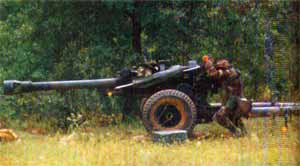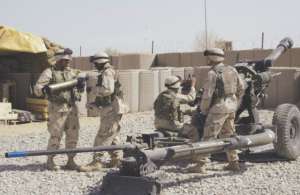| Designation: | M119A1 |
 |
|---|---|---|
| Manufacturer: | Rock Island Arsenal | |
| Product type: | Weapons & Weapon Systems | |
| Name: | Towed howitzer |
Following the success of the now BAE Systems Land Systems 105 mm L118 Light Gun during the Falkland Islands campaign, the US Army purchased operational testing weapons to determine the feasibility of using this weapon in the US Army's new light division concept.
The key in the US Army's evaluation was the ability to airlift an entire division artillery within the light division air transport constraints.
Following extensive trials, the US Army negotiated both a licence agreement, for production within the US and a production contract with the now BAE Systems Land Systems Nottingham in 1987.
Deliveries to the US Army commenced in December 1989 with the First Unit Equipped (FUE) being the 7th Infantry Division, Fort Ord, California.
The M119A1 105 mm towed howitzer is essentially the BAE Systems Land Systems 105 mm L119 Light Gun, covered in detail in a separate entry, with some modifications. For example, the installation of a US-type sighting system, to meet the requirements of the US Army.
Production of the 105 mm towed howitzer M119A1 was undertaken at Rock Island in the US with the 105 mm barrels being provided by Watervliet Arsenal.
The US Army describes the M119A1 as a lightweight, air-mobile, air-droppable, low-altitude air extraction weapon system that provides direct and indirect fire support for use in selected field artillery battalions in light infantry, airborne and air assault divisions.
Using standard 105 mm ammunition, the M119A1 can reach targets at a range of 14,300 m. The M119A1 replaced the older US developed M101A1 and M102 towed howitzers in front line service. The 105 mm M102 remains in service with some reserve units but these are due to be replaced by new build 105 mm M119A2 weapons.
There have recently been a number of new 105 mm artillery projectiles developed in the US which give the M119/M119A1 a significant range advantage.
The M915 rocket assisted projectile significantly increases lethality and improves range by 40 per cent over the standard US M1 HE projectile.
In contrast to the older M548 RAP, which uses the low end M176 propellant, the M913 uses the M229 maximum propelling charge (Charge 8, high end). The increased range is obtained by using the M229 propellant charge coupled with a modern rocket motor, which will function about 1.5 seconds after leaving the barrel. With the rocket on the M913 it provides a range of more than 19.5 km. The 105 mm towed howitzer M119A1 can also fire the more advanced natures of ammunition from South Africa.
The M916 is the same projectile as the M915 but will be fired with the M67 propellant (low end charge).
Both the M915 and M916 projectiles have a payload consisting of 42 M80 sub-munitions which incorporate a self-destruct mechanism.
The onboard fire-control system consists of an M137 panoramic telescope with a magnification of ×4, M90A2 direct fire telescope with a magnification of ×3, M186 direct fire mount and the M187 telescope mount.
In US Army service the M119A1 is normally towed by the AM General M1097 (4 × 4) Heavy HMMWV and can be quickly moved and employed to provide maximum fire power with minimum of combat loaded weight.
As the M119A1 will remain in service well into the 21st Century the US Army embarked on a major modernisation and improvement programme for the M119A1 weapon to enhance its RAM-D (Reliability, Availability, Maintainability and Durability) characteristics under the Light Artillery System Improvement Programme (LASIP).
LASIP Block I modifications included:
- Low temperature recuperator (LTR)
- Improved 12 inch brakes
- Modified trunion adapter
- Travelling and firing stays
- Improved cam follower
- Lift handles
- Trail end step
LASIP Block II modifications includes:
- LED/battery illuminated fire control (replaced tritium illumination)
- Improved elevation gearbox
- Improved buffer and LTR interconnection
- Improved rammer extraction
- Roll bar
After completion of LASIP Block I and Block II, the howitzer model designation was changed to M119A2. All M119A2 in the US Army inventory have now been converted to M119A2 standard.
Achieving US Army modularity requirements requires the acquisition of new M119A2 howitzer. Currently the plan is to acquire an additional 377 howitzers.
Initial funding for a portion of this requirement was provided in 2005 and in subsequent years. Current plans are to replace all M102 howitzers in Army National Guard Units of Action (UoA) with M119A2 Howitzers.
The first purchase was for 35 weapons through the FY05 supplemental budget for Low Rate Initial Production (LRIP).
|
||||||||||||||||||||||||
|
|||||||||||||||
 |
 |
 |
 |
 |


